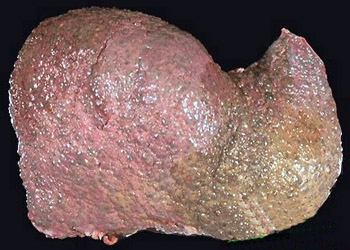 Hepatocirrhosis is a chronic, progressive or diffuse hepatic disease induced by one or various causes. Its pathological features are extensive necrosis and degeneration of the hepatic cells, diffuse proliferation of fibrous tissue and formation of regenerated nodule, structural destruction of hepatic lobules and blood vessels, which lead to gradual degeneration and cirrhosis of the liver, i.e., hepatocirrhosis. At the early stage, the disease may be symptomless; while at the later stage, hypofunction of the liver, portal hypertension and involvement of various systems may be manifested.
Hepatocirrhosis is a chronic, progressive or diffuse hepatic disease induced by one or various causes. Its pathological features are extensive necrosis and degeneration of the hepatic cells, diffuse proliferation of fibrous tissue and formation of regenerated nodule, structural destruction of hepatic lobules and blood vessels, which lead to gradual degeneration and cirrhosis of the liver, i.e., hepatocirrhosis. At the early stage, the disease may be symptomless; while at the later stage, hypofunction of the liver, portal hypertension and involvement of various systems may be manifested.
This disease usually occurs in young adults between the age of 20 - 50, and is more common in males. Infectious hepatitis and parasitization in some districts are common causes of this disease. Chronic alcoholism, malnutrition, chemicals and toxic substance, hereditary and metabolic diseases are also responsible. Moreover, the cause is unknown in some cases.
Clinically, the cases during compensatory phase of hepatic function may be included in the categories of "xie tong" (hypochondriac pain) and "ji ju" (abdominal mass) in TCM; while those during decompensatory phase are similar to "gu zhang"(tympanites) in TCM. The pathogenesis is invasion of exogenous seasonal pathogens, excessive drinking, contaminated food or emotional upset, which result in damage of the liver and spleen and stagnation of qi and blood. The kidney is also involved in longstanding cases, which causes failure of qi to discharge water and retention of water in the interior. Continue to read Causes of Cirrhosis in TCM.